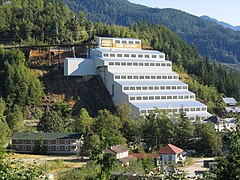Britannia Mines Concentrator
| Britannia Mines Concentrator | |
|---|---|

The 1923 steel concentrator building at Britannia Beach.
|
|
| General information | |
| Classification | Mining |
| Town or city | Britannia Beach. British Columbia |
| Country | Canada |
| Completed | January 1923 |
| Height | 210 feet (64 m) |
| Official name | Britannia Mines Concentrator National Historic Site of Canada |
| Designated | 20 November 1987 |
The Britannia Mines Concentrator is a National Historic Site of Canada. The large, inclined gravity mill was built on the northwest side of Mount Sheer to assist the transfer of copper ore through the chemical and mechanical processes of the plant. It is a landmark in Britannia Beach, British Columbia some forty-five kilometers north of Vancouver.
The nearby volcanic peak of Mount Garibaldi indicates the presence of magmatic inclusions and volcanic cores, in which copper is usually found. As such, the town and mill sit on the western shore of the Britannia Range and defined by the large fjord of Howe Sound.
The mining claims were discovered in the 1880s and the Britannia Beach Mining and Smelting Company established in the Edwardian years. Copper was first mined in the area in 1903 and the distance from smelters necessitated the construction of an ore concentrator, a system to deliver ore, and a system to ship the ore concentrate. A primitive concentrator, No. 1, was built in 1904, which was upgraded with two more units, collective known as No.2, built in 1914 and 1915. A fire in 1921 destroyed these, and a concrete and steel structure to house a new concentrator was completed (immediately to the right of the 1914 plant) in early 1923. In the late 1920s, Britannia Mines was the most productive copper mine in the British Empire, and it also produced silver and gold.
Now owned by the Britannia Beach Historical Society, it is part of the Britannia Mine Museum.
In the late 1880s prospectors from Texada Island had surveyed the area for gold, one of them Dr. A. Forbes, then staked claims. It was not until 1898 that trappers among them Oliver Furry, of Furry Creek fame, discovered sulphidedcopper ore in a mineralized schist. A set of mining claims were made, eventually leading to the establishment of Britannia Mining and Smelting Company, which included claims for mines at four sites named Bluff, Empress, Fairview, and Jane.
...
Wikipedia
